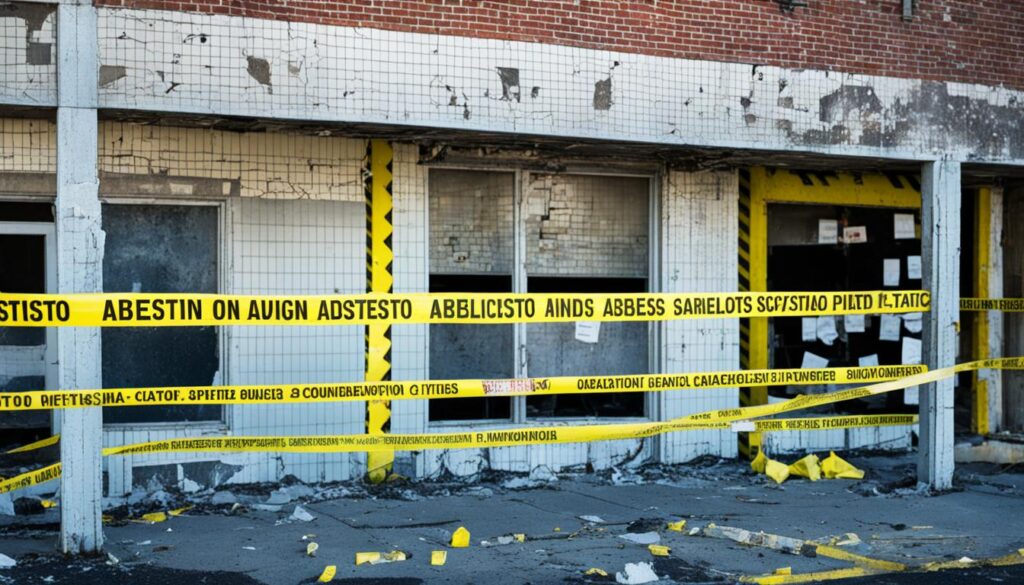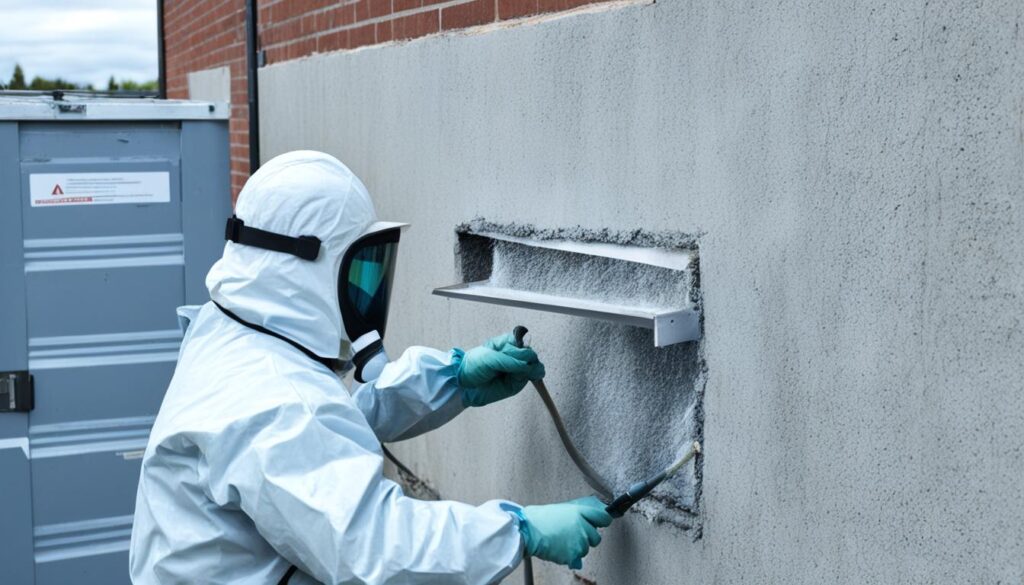Asbestos Disposal Guidelines in Swanley
Welcome to our comprehensive guide on asbestos disposal guidelines in Swanley. As responsible members of the community, it is crucial for Swanley residents to understand the importance of proper asbestos disposal to ensure the safety and well-being of ourselves and our neighbours.
Asbestos, a harmful mineral once widely used in construction materials, poses serious health risks when its fibers are inhaled. To protect ourselves and our loved ones, it is essential to dispose of asbestos-containing materials in a safe and responsible manner.
By following the expert guidelines we provide, you can confidently navigate the process of asbestos removal and disposal, secure in the knowledge that you are taking the necessary steps to protect your health and the environment. Let us guide you through the best practices for asbestos disposal, giving you peace of mind.
Key Takeaways:
- Proper asbestos disposal is crucial for the health and safety of Swanley residents.
- Asbestos poses significant health risks when its fibers are inhaled.
- By following expert guidelines, you can ensure the safe removal and disposal of asbestos-containing materials.
- Responsible asbestos disposal protects the well-being of the community and the environment.
- Follow our comprehensive guide for peace of mind in asbestos disposal.
Understanding Asbestos and its Risks
In this section, we will delve into the dangers of asbestos and its potential health risks. It is crucial for Swanley residents to understand the importance of proper disposal to prevent any harm to themselves and the surrounding environment.
Asbestos, a naturally occurring mineral, was once widely used in construction due to its fire-resistant qualities and durability. However, extensive research has revealed the hazardous nature of asbestos fibers when inhaled. The microscopic fibers can become trapped in the lungs, leading to serious health conditions.
The Risks of Asbestos Exposure
Exposure to asbestos can result in various respiratory diseases, including asbestosis, lung cancer, and mesothelioma. These illnesses may take years or even decades to develop, making early detection and preventive measures crucial.
Asbestos-related diseases can affect anyone who is exposed to asbestos fibers. It is not limited to those who worked directly with asbestos-containing materials. Secondhand exposure is also a significant concern, as individuals living or working in buildings with deteriorating asbestos materials may unknowingly breathe in the dangerous fibers.
“Asbestos is not to be taken lightly. It is a known carcinogen and poses significant risks to human health. It is essential to educate ourselves about the dangers and take appropriate measures to protect ourselves and our loved ones.” – Dr. Sarah Collins, Environmental Health Specialist
Identifying Asbestos-Containing Materials
Asbestos can be found in various building materials, such as insulation, roofing shingles, floor tiles, and cement products. It is often challenging to identify asbestos visually, as the fibers are microscopic. Therefore, it is crucial to exercise caution when renovating or demolishing older buildings, especially those constructed before the 1990s.
If you suspect the presence of asbestos in your home or workplace, it is best to consult a licensed asbestos professional for inspection and testing. They can accurately identify asbestos-containing materials and recommend appropriate actions to ensure safety.
Protecting Yourself and Others
Proper asbestos disposal is essential to protect yourself, your family, and the environment. Never attempt to remove or dispose of asbestos-containing materials without professional guidance. Improper handling can release asbestos fibers into the air, putting everyone nearby at risk of exposure.
Always hire a licensed asbestos contractor to safely remove and dispose of asbestos materials. They have the expertise, equipment, and training to handle asbestos-containing materials without risk. Additionally, follow any guidelines or regulations set forth by local authorities to ensure compliance and safety.
By understanding the risks associated with asbestos and taking appropriate measures, Swanley residents can protect themselves and contribute to the collective well-being of the community.

Safe Removal and Disposal Procedures
When it comes to handling asbestos safely, following proper removal and disposal procedures is crucial for the well-being of both Swanley residents and the surrounding environment. In this section, we will outline step-by-step guidelines to ensure the safe removal and disposal of asbestos-containing materials.
1. Conduct a Risk Assessment
Prior to initiating any asbestos removal or disposal tasks, it’s essential to conduct a thorough risk assessment. Identify all potential sources of asbestos in your property and assess their condition, noting any damage or deterioration that could release harmful fibers into the air.
2. Engage a Certified Asbestos Removal Contractor
Safe asbestos removal requires the expertise of certified professionals who specialize in handling hazardous materials. Engage a licensed asbestos removal contractor who follows industry regulations and has the necessary training and equipment to carry out the removal process safely.
3. Secure the Area
Before commencing any removal activities, it’s important to isolate the work area to prevent the spread of asbestos fibers. Seal off the contaminated area with plastic sheets and use tape to ensure an airtight enclosure. Display clear warning signs to restrict access and protect individuals from potential exposure.
4. Use Personal Protective Equipment (PPE)
When handling asbestos, personal protective equipment (PPE) is essential to protect workers and minimize the risk of exposure. Ensure that anyone involved in the removal process wears suitable PPE, including disposable coveralls, gloves, respiratory protection (such as a high-efficiency particulate air (HEPA) filter mask), and disposable shoe covers.
5. Wet Down Asbestos Materials
To minimize the release of asbestos fibers during removal, it is necessary to wet down asbestos-containing materials using a fine water spray. This helps to control dust and prevent fibers from becoming airborne, reducing the risk of inhalation.
6. Remove Asbestos Materials Carefully
When removing asbestos-containing materials, it is important to exercise caution and prevent unnecessary damage. Minimize the use of power tools, as they can generate dust, and instead opt for manual removal methods. Carefully package the removed materials in labeled, double-bagged polythene bags or secure containers.
7. Dispose of Asbestos Properly
Ensure the safe disposal of asbestos-containing materials by following local regulations and guidance. Contact your local authority to determine the designated waste disposal site that accepts asbestos. Double-check packaging requirements, labeling, and transportation instructions to ensure compliance.
By adhering to these safe removal and disposal procedures, Swanley residents can responsibly manage asbestos in their properties, safeguarding their health and contributing to a safer environment for all.

| Key Steps | Purpose |
|---|---|
| Conduct a Risk Assessment | To identify potential sources of asbestos and assess their condition |
| Engage a Certified Asbestos Removal Contractor | To ensure safe and professional removal by experts |
| Secure the Area | To isolate the work area and prevent the spread of asbestos fibers |
| Use Personal Protective Equipment (PPE) | To protect individuals involved in the removal process |
| Wet Down Asbestos Materials | To control dust and reduce the risk of fiber release |
| Remove Asbestos Materials Carefully | To prevent unnecessary damage and fiber release during removal |
| Dispose of Asbestos Properly | To ensure safe and compliant disposal of asbestos-containing materials |
Conclusion
In conclusion, ensuring the safe and responsible disposal of asbestos is of paramount importance for Swanley residents. By following our expert guidelines, you can protect your health and the well-being of your community. By understanding the risks associated with asbestos and the proper procedures for removal and disposal, you can achieve peace of mind knowing that you are taking the necessary steps to safeguard yourself and those around you.
Remember, asbestos poses a significant threat to human health, and its improper handling can lead to serious consequences. By strictly adhering to the guidelines outlined in this article, you can prevent the release of harmful asbestos fibers, reducing the risk of asbestos-related illnesses.
Our team of experts is here to assist you every step of the way. Whether you need guidance on identifying asbestos-containing materials or require professional assistance in disposing of asbestos safely, we are just a phone call away. Together, let’s make Swanley a safer place for everyone by practicing responsible asbestos removal and disposal.
